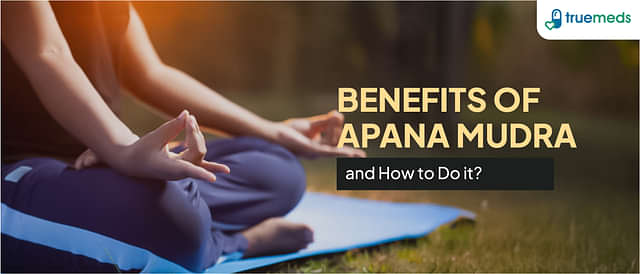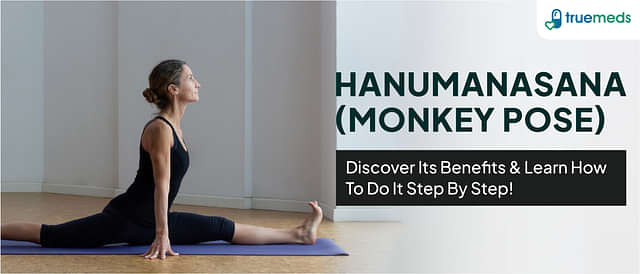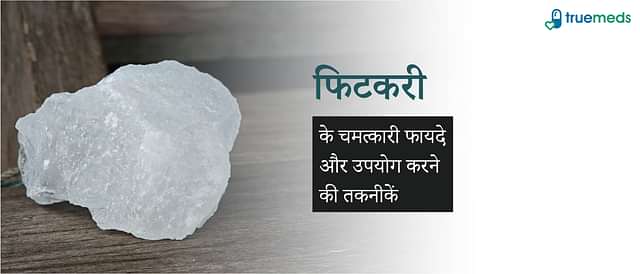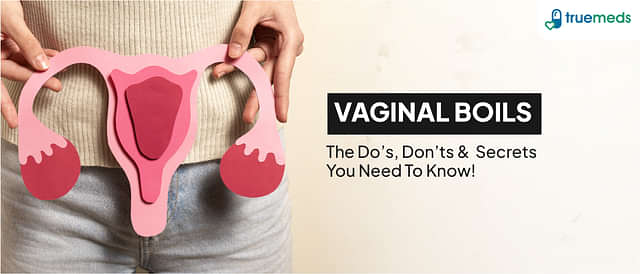Discover the Health Benefits of Matsyasana: Yoga’s Fish Pose
Last updated on : 08 Jul, 2025
Read time : 10 min
Introduction
Yoga is an age-old Indian discipline that has long been praised for its comprehensive approach to mental, physical, and spiritual health. Matsyasana, also known as fish pose yoga, is one of the many yoga poses that are very beneficial to the body and mind. This article explores the nuances of matsyasana, covering everything from how to do it to its many health advantages. It will help you grasp the significance of the pose and the safety measures required to perform it correctly.
What is Matsyasana (Fish Pose)?
The name of the posture, Matsyasana, comes from the Sanskrit words “Matsya” (fish) and “Asana” (pose), since when done properly, the body mimics a fish swimming in water. As a counter-position to Sarvangasana (Shoulder Stand), this reclining back-bending pose is commonly suggested since it opens the chest and stretches the front of the body. When performed in water, Matsyasana is supposed to enable a yogi to float like a fish, signifying the ease and fluidity the position imparts to the body.
How to do Matsyasana (Fish Pose)?
To fully benefit from and prevent damage from Matsyasana, correct technique and mindfulness are required. For a secure and productive practice, adhere to the following guidelines:
- Preparation: The first step in preparation is to lie flat on your back with your knees together and your arms comfortably by your sides. To centre yourself, let your body relax and take several deep breaths.
- Leg Positioning: With your palms facing down, place your hands beneath your hips. Make sure your forearms are parallel, and move your elbows closer to one another.
- Arch the Back: Take a deep breath and raise your upper body off the ground by pressing onto your forearms and elbows. Lean back and let your head sag slightly to the back.
- Head Placement: Rest the crown of your head on the mat with as little weight as possible to prevent neck strain. Lift your chest to create a deep stretch in the throat and chest.
- Hold: Hold the posture for 15-30 seconds while breathing deeply and steadily. Focus on expanding your chest with each inhale and relaxing deeper into the stretch with each exhale.
- Release: To exit the posture, gently lift your head off the floor first, then lower your chest and return to your mat. Remove your hands from beneath your hips and relax your body.
Top Benefits of Matsyasana (Fish Pose)
Matsyasana provides numerous benefits that promote general health and well-being. Let’s explore these matsyasana benefits:
1) Help Enhance Spinal Flexibility
Matsyasana is particularly good for increasing spinal flexibility. When you arch your back in this pose, you produce a deep stretch along your spine, which improves general flexibility. This increased flexibility is essential for keeping a healthy spine because it allows for a wider range of motion and keeps the spinal discs hydrated and supple. Matsyasana, which encourages the natural curve of the spine, can help you improve your posture and reduce the danger of developing a hunched back if you practice it frequently. Increased spinal flexibility can also help with back pain by reducing muscular tension and improving alignment.
2) Help Open the Chest and Lungs
One of the most notable benefits of Matsyasana is its ability to open the chest and enlarge the lungs. In this posture, arch your back and lift your chest to stretch the intercostal muscles between the ribs, allowing the lungs to expand more. This increased lung capacity can dramatically improve respiratory function, allowing for deeper and more efficient breathing. This pose is especially good for people with respiratory disorders like asthma since it clears the airways and improves oxygen intake. Matsyasana, when practised regularly, helps strengthen your respiratory muscles and improve your general lung health.
3) Help stimulate the Thyroid
The neck stretch in Matsyasana stimulates the thyroid and parathyroid glands. These glands in the neck regulate the body’s metabolism and calcium levels. When you execute Matsyasana, the stretch in your neck increases blood flow to these glands, boosting their proper function. This stimulation can help to control your metabolism, allowing your body to convert food into energy more efficiently. Furthermore, by affecting calcium levels, Matsyasana can help maintain healthy bones and teeth, as well as correct muscle and nerve function.
4) Help Relieves Tension in the Neck and Shoulders
Neck and shoulder discomfort is typical among persons who spend long hours sitting at a desk or working on a computer. Matsyasana provides an effective solution for this problem. This position stretches and relaxes the muscles in the neck and shoulders by expanding the chest and elongating them. This can effectively relieve stiffness and pain in certain locations. The deep stretch also encourages good posture, preventing the forward head position that causes neck and shoulder stress. Incorporating Matsyasana into your yoga practice can assist to offset the consequences of a sedentary lifestyle and maintain your upper body pain-free.
5) Help Improves Digestive Health
Matsyasana’s gradual arching of the back reaches the abdomen, delivering a relaxing massage to the internal organs. This stimulation can improve digestive performance by encouraging food flow through the digestive tract and increasing enzyme release. Matsyasana can aid with typical digestive concerns like bloating, gas, and constipation. This pose promotes healthier digestion, which helps your body absorb nutrients and expel waste more efficiently. Improved gut health can lead to increased energy and well-being.
6) Help Boosts Mood and Reduces Stress
Matsyasana is noted for its capacity to open the heart chakra, which is linked to compassion, love, and emotional equilibrium. Practising this pose can help relieve mental stress and promote inner peace and harmony. Matsyasana involves deep, regular breathing, which helps to reduce stress and anxiety. Deep breathing activates the parasympathetic nervous system, which promotes relaxation and reduces stress hormone levels in the body. This can help improve your mood, reduce anxiety, and boost your general mental health.
7) Help Improves Circulation
Matsyasana has another key benefit: improved circulation. The pose improves blood flow throughout the body by causing a slight stretch in the chest and abdomen. This improved circulation ensures that all regions of the body get enough oxygen and minerals, which is critical for overall health and vigour. Improved blood flow can also help to remove toxins from the body, promote a healthy complexion, and help the immune system work properly. By practising Matsyasana on a daily basis, you may help to keep your circulatory system in peak shape, resulting in increased energy and well-being.
Things to Keep in Mind Before Practicing Matsyasana Yoga
Before beginning to practice fish pose yoga, consider the following guidelines to ensure a safe and effective experience:
- Warm-up: Perform a gentle warm-up exercise to prepare your body for the backbend and avoid injury.
- Breathe Deeply: To maximize the pose’s advantages and maintain stability, focus on deep, rhythmic breathing throughout
- Listen to Your Body: Don’t push yourself too hard. If you feel pain or discomfort, relax out of the pose and consult with a yoga instructor.
- Use Props: For extra support and comfort, beginners can place a folded blanket or a bolster under their back.
Tips to Practice the Fish Pose (Matsyasana)
To improve your Matsyasana practice, keep these suggestions in mind:
- Alignment: Keep your forearms and elbows close together to help your upper body rise and stay balanced.
- Engage Core Muscles: Use your core muscles to protect your lower back and maintain the pose.
- Head Placement: Exercise caution when positioning your head. To reduce neck discomfort, the crown should bear as little weight as possible.
- Gradual Progression: Begin with shorter hold times and gradually increase them as your flexibility and strength improve.
- Use a Mirror: Begin by practising in front of a mirror to ensure proper alignment and make any required modifications.
Who should avoid Matsyasana?
Matsyasana is good; however, it may not be appropriate for everyone. Individuals with the following conditions should avoid this position.
- Neck or Back Injuries: Matsyasana should be avoided by those who already have neck or back ailments to avoid worsening their condition.
- High or Low Blood Pressure: This position may not be appropriate for people who have uncontrolled blood pressure.
- Migraines or Severe migraines: In people who are prone to migraines, the head position in Matsyasana might cause or intensify them.
- Pregnancy: Pregnant women should avoid this position, particularly in the later stages, because of the deep backbend and abdominal pressure.
Some Precautions to Take While Practicing Matsyasana (Fish Pose)
Take the following safety measures to guarantee a safe practice:
- Prevent Overarching: Refrain from pushing your back into an arch. Stretch in a comfortable manner to avoid being hurt.
- Support Your Neck: To prevent strain, make sure your neck is at ease and not carrying an excessive amount of weight.
- Gradual Entry and Exit: To avoid putting undue tension on the muscles and joints, enter and exit the posture slowly and deliberately.
- Speak with a Professional: Before performing Matsyasana, if you have any medical ailments or concerns, speak with a trained yoga instructor or your healthcare professional.
Conclusion
Matsyasana, or Fish Pose, is a potent yoga pose with several health advantages. These include increased flexibility, better respiratory function, mood enhancement, and stress relief. When done carefully and correctly, Matsyasana can be a beneficial addition to your yoga practice and improve your physical and mental health. To guarantee a safe and helpful practice, remember to take the required safety precautions and seek professional advice when necessary. Accept Matsyasana and experience the significant effects it can have on your well-being.
FAQs
People with serious neck or lower back injuries, high blood pressure, migraines, or heart conditions should avoid Matsyasana. It’s also not recommended for those with knee injuries or severe spondylitis.
Matsyasana is believed to open the heart chakra (Anahata), fostering emotional balance, compassion, and a sense of inner peace. It helps release emotional tension and enhances spiritual awareness.
Matsyasana can be held for 15 to 30 seconds for beginners, gradually increasing to 1-2 minutes as one becomes more comfortable with the pose. It’s important to listen to your body and not overextend.
Matsyasana helps tone abdominal muscles and improve digestion, which, when combined with a healthy diet and regular exercise, can reduce belly fat.
Disclaimer
This article is for informational purposes only and is not a substitute for professional medical advice. Please consult a healthcare provider before beginning any new wellness practice, especially if you have an existing medical condition or are on medication.
References:
- Yoga Postures | International Day of Yoga | MEA [Internet]. Ministry of External Affairs, Government of India. 2022. (n.d.). https://mea.gov.in/yoga-postures-16.htm
Disclaimer
Our healthcare experts have carefully reviewed and compiled the information presented here to ensure accuracy and trustworthiness. It is important to note that this information serves as a general overview of the topic and is for informational purposes only. It is not intended to diagnose, prevent, or cure any health problem. This page does not establish a doctor-patient relationship, nor does it replace the advice or consultation of a registered medical practitioner. We recommend seeking guidance from your registered medical practitioner for any questions or concerns regarding your medical condition.
Popular Articles
Recommended Articles
Recent Articles
Company
About UsHealth ArticleHealth StoriesDiseases & Health ConditionsAyurvedaAll MedicinesAll BrandsNeed HelpFAQSubscribe
Registered Office Address
Grievance Officer
Download Truemeds
Contact Us
Our customer representative team is available 7 days a week from 9 am - 9 pm.
v4.3.8
2025 - Truemeds | All rights reserved. Our content is for informational purposes only. See additional information.
Our Payment Partners



















































